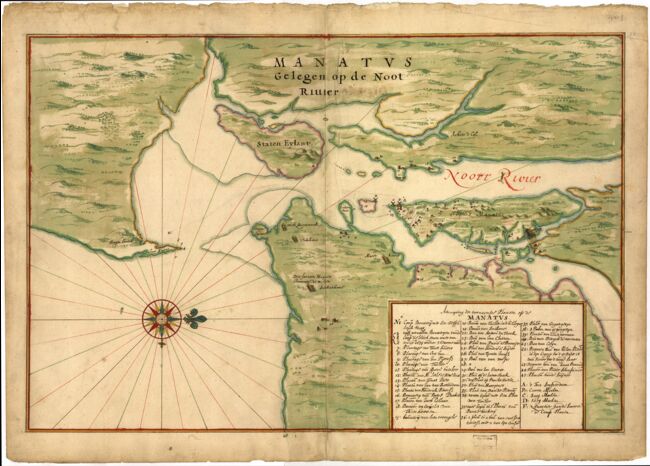“Earth, earth! This cry echoed from the top of the New Netherlands and raises with emotion the hundred passengers who crowd on the bridge. It is May 4, 1624. Having left Amsterdam seven weeks earlier, after a smooth crossing, the founders and first inhabitants of what would become New Amsterdam – then New York – saw soft green hills looming, a huge forest in the distance. In a beautifully documented book (Pierre Minuit, the man who bought Manhattan, ed. Jourdan, 2013), Yves Vander Cruysen looks back on the origins of the megalopolis. In particular on the significant fate of the discoverer of the place, who will give his name to the channel where the vessel of the first settlers will enter. In 1609, Henry Hudson, an Englishman sailing on behalf of the Dutch, had already traveled up this river for nearly 150 kilometers, in search of the “Northwest Passage”. In other words, the absolute dream for an explorer: the transcontinental river which would finally prevent European maritime trade from the perilous detour via the Cape of Good Hope to reach rich Asia. Hudson’s disappointment. Even more of the Dutch. The explorer then turned to his country of origin and convinced the English shipowners of the existence of this passage, of the imminence of its discovery. In 1610 a new expedition was therefore organized. Fatal. His ship, the Discovery, found himself stuck in the Arctic ice. The crew, overwhelmed by Hudson’s obstinacy, mutinied and disembarked the explorer with his teenage son and seven other unfortunate people in a rowboat that was abandoned adrift. We will never hear from them again …
“” The island of Manhatta “is full of game, not at all hostile to an installation …”
When the first settlers land in the bay, they know little or nothing about it. The only evocations are the writings of Robert Juet, one of Hudson’s companions, who had seen “the island of Manhatta” (“the island of many hills”, in native language). The region, writes Juet, is “full of game, not at all hostile to an installation”. He mentions “a very beautiful port, with greenery, flowers and majestic trees”. The newcomers discover at the end of the bay the rudimentary fort built by Adriaen Blok during an accidental stopover in 1614 – he and his sailors were arguably the first Europeans to set foot on this soil.
Smallpox, measles, malaria and plague brought from Europe will wreak havoc on the indigenous population
However, for the Dutch, owning land means first of all occupying it. A few men landed on Île aux Noix (now Grosvenor Island) to build a fort on the neighboring island of Manhattan. One group goes up the current Delaware River, yet another the current Connecticut River, about twenty families remain on board the New Netherlands and go up the Mauritius River (future Hudson River) named in homage to Prince Maurice of Nassau, Governor of the United Provinces. Many of the arrivals are Calvinist Walloons who were driven from present-day Belgium to the Netherlands and Germany by religious persecution and the Spanish occupation before rushing them to the New World. Thus Georges Rapaille, who dutched his name in Rapalje, and his wife Catherine. Arrived without a penny, they will have eleven children, will become rich landowners by buying land from the Indians on the other side of the Mauritius River, in the village of Breukelen, which will become Brooklyn. The testimony of a certain William Wood evokes the amazement of the Indians: “They took the ship for a floating island, the mast for a tree, the sail for white clouds, and the artillery discharges for lightning and thunder. “ They are about 20,000 and bear the name of “Lenapes” which means “the common people”. They are from the Algonquin family, divided into several related tribes such as the Raritans on present-day State Island, the Mohawks further inland or the Manhattes on Manhattan Island. The Company of the West Indies required of each migrant, before his departure, his signature at the bottom of a charter which stipulates, among other things, the “need to be respectful, in all matters, of Indians”. Relations between Europeans and Amerindians, initially cordial, soon deteriorate. Above all, diseases brought from Europe such as smallpox, measles, malaria and plague will wreak havoc on the indigenous population which, soon reduced to only a few thousand individuals, will gradually recede into the land.
This drama was only at its beginnings, however, when a man arrived on the island of Manhattan in 1626 who would soon become legendary. His name is Pierre Minuit (or Pieter Minnewit). He was born around 1585, in Wesel, Germany, to a Calvinist family from Tournai. He established himself in Utrecht, offered his services to the Company of the West Indies which he knew not to be satisfied with the performance of the new colony.
The first stores were full of beaver, otter and lynx furs
His business development plan seduced the Dutch to the point that they appointed him governor. Midnight travels with horses, cows, pigs, sheep, all the cattle claimed by the colonists and which we hope will multiply in the New World. The new governor discovers barely a village at the southern tip of Manhattan. Four earthen bastions surmounted by rough palisades where the governor’s accommodation, merchandise stores and especially furs (beavers, otters, lynx, mink) are located, which is the raison d’être of the establishment. Further on, around thirty houses, more like huts, a mill and a few farms surrounded by fields of wheat and cereals. Midnight creates a council of five notables, decides to refocus the colony on Manhattan by grouping together the too dispersed families for the purpose of defense and development. The island seemed to him ideal for agriculture as for irrigation, well placed at the mouth of the river, accessible to large boats as to pirogues of Indian traders. These are favored, even used as scouts. The fort that he rebuilt as a solid defense not against them, but against the other colonial powers (the English in New England and Virginia, the French in Canada, the Spaniards in the south). A road is traced on the island to the village to bring the wheat there. We call it Breedweg, the “bread route” – the future Broadway. Finally, above all, Pierre Minuit decided to buy the island from the Indians.
60 guilders (a little over 1000 dollars today) against the 22,000 acres of the island!
According to legend, the ceremony took place on May 26, 1626, in the north of the island, in the middle of the woods and caves inhabited by the Manhattes. According to testimonies, each camp would have put on its finest pageantry: warlike outfits for the Indians, “enormous hats” (à la Rubens) for the European officials. Cloths, axes, kitchen utensils, worth 60 florins (a little over $ 1,000 today) are exchanged for the 22,000 acres of the island! History can tell of one of the greatest real estate deals of all time, and the descendants of Indians (who had no sense of ownership) of a deception that marked the beginning of their end. Minuit nevertheless guarantees the natives a monopoly of the fur trade, a rich clientele in Europe and the protection of the whites against other tribes … In 1630, he bought Staten Island for the same paltry sum. The Compagnie des Indes can hire its services. But Minuit criticizes him for always granting more freedoms to private investors to develop the colony further inland. Midnight is finally dismissed in 1632. Disgusted, he yields to the solicitations of Sweden, conquers the current Maryland, Delaware and part of Pennsylvania for Queen Christine, founded Fort Christina (current Wilmington), before disappearing on August 5, 1638 in the Caribbean Sea, his ship blown by a hurricane …

This “New Sweden” was finally absorbed, in 1655, by the Dutch. They are headed by Pieter Stuyvesant. This governor of New Amsterdam is also the best known, because he was the last and because his mandate – seventeen years – was the longest. Born in 1610, son of a pastor, former governor of the island of Curaçao from where he introduced in New Holland (from Brazil) the black slave trade to alleviate the eternal financial difficulties of the Company, this strong character , nicknamed by his enemies the “Grand Duke of Muscovy”, has a wooden leg: he fought fiercely against the Spaniards in 1644 to take back the island of Saint-Martin. Under his government (1647-1664), the population of Nieuw Amsterdam goes from 300 to 1,500 inhabitants. The colony itself has more than 10,000. The city developed with tall, narrow houses, with brick facades, stepped gables, with a canal, dug in 1654, spanned by three wooden bridges. A perimeter wall is built from one side of the island to the other (from the Hudson to the East River), which will give its name to a famous street, Wall Street, the rue du Mur.
In the summer of 1664, four English warships appeared in the bay. Panic in Manhattan
This construction will however not be of any help against the British claims. The modest economic development of New Holland worried the Parliament of Oliver Cromwell who, in 1651, decreed that only English ships could import goods into English ports. War breaks out, a heavy blow against Dutch supremacy in the North Atlantic. London wants to oust Amsterdam. At the beginning of the 1660s, King Charles II decided to offer his brother Jacques Stuart, Duke of York, the lands located between Virginia and New England. New Amsterdam, for Her Britannic Majesty, simply does not exist, the Dutch have nothing to do in this part of the world. In the summer of 1664, four English warships appeared in the bay. Panic in Manhattan. Pieter Stuyvesant wants to resist, then gives up under pressure from the inhabitants who fear looting and destruction. Stuyvesant, at the head of his Dutch garrison, embarked with dignity to return to Amsterdam (he returned four years later to his dear city to die there in 1672, respected by all, even by the English). On September 8, 1664, New Amsterdam ceased to exist. The city, as a sign of allegiance to its new prince, will now be called New York.
READ ALSO
>>> New Angoulême: what if New York had been French?
>>> How did New York win its independence from the English?
>>> What to do in New York when you love nature?
–


